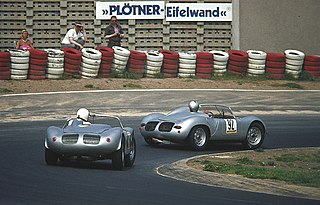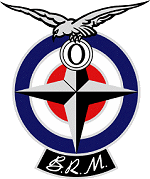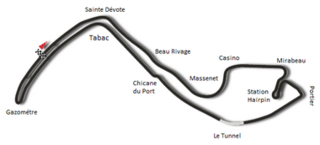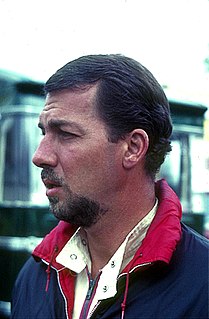
The Porsche 718 is a series of one- or two-seat sports-racing cars built by Porsche from 1957 to 1962. An open-wheel single-seat model was developed for Formula racing.

Daniel Sexton Gurney was an American racing driver, race car constructor, and team owner who reached racing's highest levels starting in 1958.

The Porsche 804 is a single-seat, open-wheeled racing car produced by Porsche to compete in Formula One (F1). It raced for a single season in 1962 in the 1½ litre formula.

British Racing Motors (BRM) was a British Formula One motor racing team. Founded in 1945 and based in the market town of Bourne in Lincolnshire, it participated from 1951 to 1977, competing in 197 grands prix and winning seventeen. BRM won the constructors' title in 1962 when its driver Graham Hill became world champion. In 1963, 1964, 1965 and 1971, BRM came second in the constructors' competition.

The 1959 Dutch Grand Prix was a Formula One motor race held at Zandvoort on 31 May 1959. It was the ninth Dutch Grand Prix. The race was held over 75 laps of the four kilometre circuit for a race distance of 314 kilometres. It was race 3 of 9 in the 1959 World Championship of Drivers and race 2 of 8 in the 1959 International Cup for Formula One Manufacturers.

The 1960 United States Grand Prix was a Formula One motor race held on November 20, 1960, at Riverside International Raceway in Riverside, California. It was race 10 of 10 in the 1960 World Championship of Drivers and race 9 of 9 in the 1960 International Cup for Formula One Manufacturers.

The 1962 French Grand Prix was a Formula One motor race held at Rouen-Les-Essarts on 8 July 1962. It was race 4 of 9 in both the 1962 World Championship of Drivers and the 1962 International Cup for Formula One Manufacturers. The race was won by Dan Gurney, his first Formula One victory, driving a Porsche, that company's only win as a constructor in a Formula One championship race coming after three years of racing. It was the third time that the French Grand Prix was held at Rouen, last time being 1957.

The 1966 Monaco Grand Prix was a Formula One motor race held at the Circuit de Monaco on 22 May 1966. It was race 1 of 9 in both the 1966 World Championship of Drivers and the 1966 International Cup for Formula One Manufacturers. The race was the first World Championship event of a new era for Formula One, for which engine regulations were altered from 1.5 litres of maximum engine displacement to 3.0 litres. The race was the 24th Monaco Grand Prix.
The 1961 Formula One season was the 15th season of Formula One motor racing. It featured the 1961 World Championship of Drivers and the 1961 International Cup for F1 Manufacturers, which were contested concurrently from 14 May to 8 October over an eight race series. The season also included numerous non-championship races for Formula One cars.
The 1960 Formula One season was the 14th season of the FIA's Formula One motor racing. It featured the eleventh FIA World Championship of Drivers, the third International Cup for F1 Manufacturers and numerous non-championship Formula One races. The World Championship commenced on 7 February 1960 and ended on 20 November after ten races. Jack Brabham won his second consecutive title with his Cooper team defending its constructors' title.

The Dutch Grand Prix is a Formula One automobile race held at Circuit Zandvoort, North Holland, Netherlands, from 1948 to 1985 and due to be held from 2021 onwards. It was a part of the World Championship from 1952, and designated the European Grand Prix twice, 1962 and 1976, when this title was an honorary designation given each year to one Grand Prix race in Europe.

Joakim Bonnier was a Swedish sportscar racing and Formula One driver who raced for various teams. He was the first Swede to both enter and win a Formula One Grand Prix.

Pedro Rodríguez de la Vega was a Mexican Grand Prix motor racing driver. He was the older brother of Ricardo Rodríguez. His most notable successes were in Formula One, where he won the 1967 South African Grand Prix driving a Cooper-Maserati and the 1970 Belgian Grand Prix in a BRM, and in the World Sportscar Championship where he was a principal Porsche factory driver in winning both the 1970 and 1971 titles. He was killed on 11 July 1971 while competing in a Ferrari during an Interserie sports car race in Nuremberg, West Germany.
The British Racing Motors V16 was a supercharged 1.5 litre V-16 cylinder racing engine built by British Racing Motors (BRM) for competing in Formula One motor racing in the immediate aftermath of World War II. Designed in 1947 and raced until 1954–55, it produced 600 bhp (450 kW) at 12,000 rpm, although test figures from Rolls-Royce suggested that the engine would be able to be run at up to 14,000rpm.

The McLaren M7A and its M7B, M7C and M7D variants were Formula One racing cars, built by McLaren and used in the world championship between 1968 and 1971. After two relatively unsuccessful years of Formula One competition, the M7A was used to score McLaren's first win at the 1968 Belgian Grand Prix.
Four-wheel drive (4WD) has only been tried a handful of times in Formula One. In the World Championship era since 1950, only eight such cars are known to have been built.

The BRM P261, also known as the BRM P61 Mark II, is a Formula One motor racing car, designed and built by the British Racing Motors team in Bourne, Lincolnshire, England. The BRM P261 was introduced for the 1964 Formula One season, and its design was an evolution of Tony Rudd's one-off BRM P61 car of 1963. The P261 had a relatively long racing career; variants of the car were still being entered for Formula One World Championship Grands Prix as late as 1968. During the course of their front-line career BRM P261s won six World Championship races, in the hands of works drivers Graham Hill and Jackie Stewart, and finished second in both the Drivers' and Constructors' Championship standings in 1964 and 1965. Stewart, Hill and Richard Attwood also used works P261s to compete in the Tasman Series in 1966. The BRMs dominated, with Stewart winning four, Hill two, and Attwood one of the 1966 Tasman Series' eight races. Stewart also won the title. The works-backed Reg Parnell Racing team returned in 1967 with Stewart and Attwood, where Stewart added another two wins to his tally. In terms of races won and total Championship points scored, the P261 was the most successful car in BRM's history.

The BRM Type 15 was a Formula One racing car of the early 1950s, and the first car produced by British Racing Motors. The car was fitted with a revolutionary and highly complex supercharged 1.5-litre British Racing Motors V16 which produced considerably more power than any of its contemporaries.

The BRM P25 was a Formula One racing car raced from 1955 to 1960 and the second car produced by the British Racing Motors consortium. After the failure of the complex BRM V16, the P25's design emphasized simplicity. The car was fitted with a 2.5-litre straight-4 engine, producing some 275 horsepower. The P25 would be the foundation of BRM's successes in the late 1950s and early 1960s.

The BRM P57,, was a Formula One racing car built to race in Formula One from 1962 to 1965.
















